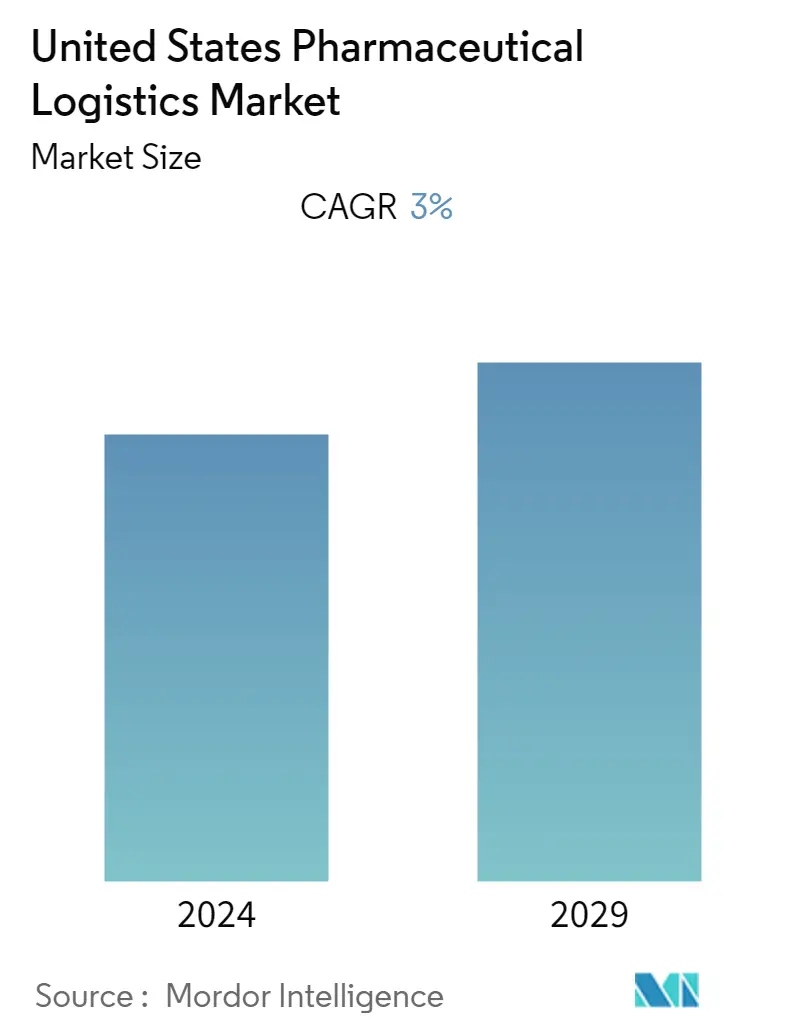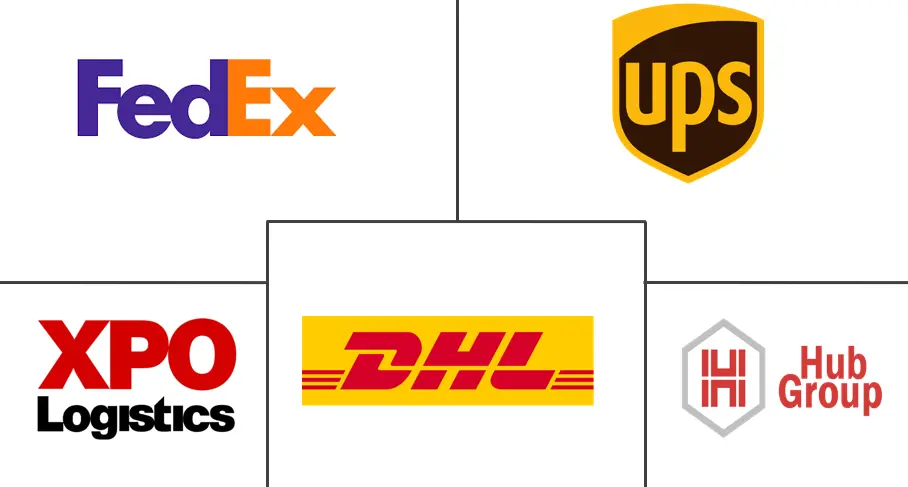Market Size of United States Pharmaceutical Logistics Industry

| Study Period | 2019 - 2029 |
| Base Year For Estimation | 2023 |
| Forecast Data Period | 2024 - 2029 |
| Historical Data Period | 2019 - 2022 |
| CAGR | 3.00 % |
| Market Concentration | Medium |
Major Players
*Disclaimer: Major Players sorted in no particular order |
US Pharmaceutical Logistics Market Analysis
The United States Pharmaceutical Logistics Market is estimated to register a CAGR of 3% during the forecasted time period.
- Transportation problems were making it hard to distribute COVID-19, which was causing problems in the drug supply chain.Port disruptions, quarantined personnel, and labor shortages caused by lockdowns were all factors. Furthermore, COVID-19 slowed the development of new pharmaceutical products due to material shortages, interruptions in clinical trials, and delays in FDA clearance. Customers were more inclined to stay at home and avoid in-person pharmacies to avoid infection; therefore, distribution efforts turned primarily to at-home delivery systems, such as internet pharmacies and assistive applications.
- In the United States, there has been a big increase in the production of generic drugs because they are cheaper than brand-name drugs and don't need as much research and testing.Generic drugs have also helped keep the country's health care system going by making it easier for patients to get the care they need and saving money for taxpayers, employers, and insurance companies.As a result, the US government is pushing the use of generic pharmaceuticals in order to reduce the country's healthcare spending.
- Pharmaceutical distributors are at the core of the healthcare ecosystem in the United States. Distributors manage 92% of pharmaceutical sales, bringing efficiency and order to a supply chain that connects two extremely fragmented markets: 1,300 manufacturers and 180,000+ points of sale. With the increased shipment of medicines, life sciences, and medical devices throughout the world, the majority of it is coming from the United States and Europe.
- Even though regulations are getting stricter, the biopharmaceutical industry is sending more shipping and distribution jobs to third-party logistics firms. Because of this, electronic cargo monitoring, which includes reporting on where the cargo is and how it is doing in almost real time, is becoming a popular alternative.
US Pharmaceutical Logistics Industry Segmentation
In general, pharmaceutical logistics is about the handling, transport, and management of the supply chain for many different kinds of products, most of which need to be handled in a certain way. The US pharmaceutical logistics market is segmented by product (generic drugs and branded drugs), mode of operation (cold chain transport and non-cold chain transport), and service (transport (road, air, rail, and sea), warehousing services, value-added services, and others). Additionally, the report offers market size and forecasts for the United States pharmaceutical logistics market in value (USD billion) for all the above segments.
| By Product | |
| Generic Drugs | |
| Branded Drugs |
| By Mode of Operation | |
| Cold Chain Transport | |
| Non-cold Chain Transport |
| By Services | ||||||
| ||||||
| Warehousing Services | ||||||
| Value-added Services and Other Services |
United States Pharmaceutical Logistics Market Size Summary
The United States pharmaceutical logistics market is poised for steady growth, driven by the increasing demand for efficient distribution systems and the rising production of generic drugs. The market is characterized by a fragmented landscape with numerous international and local companies competing to offer secure and cloud-based supply chain solutions. The shift towards at-home delivery systems, accelerated by the COVID-19 pandemic, has further emphasized the need for robust logistics frameworks. Pharmaceutical distributors play a crucial role in this ecosystem, managing a significant portion of pharmaceutical sales and ensuring the smooth operation of a complex supply chain that connects manufacturers with numerous points of sale. The market's growth is also supported by advancements in cold storage processes, which are essential for maintaining the quality of temperature-sensitive products like vaccines and medications.
Despite the challenges posed by stricter regulations and government cost control policies, the United States remains a leader in pharmaceutical research and development, holding a substantial share of the global pharmaceutical market. The biopharmaceutical industry is increasingly outsourcing shipping and distribution tasks to third-party logistics firms, which is driving the adoption of electronic cargo monitoring solutions. The market is witnessing significant activity, with major logistics companies merging to expand their reach and enhance their technological capabilities. The production stores sector is expected to experience rapid growth, supported by the extensive cold storage capacity available in states like Florida, Washington, and Texas. These developments indicate a dynamic and evolving market landscape, with opportunities for growth and innovation in pharmaceutical logistics.
United States Pharmaceutical Logistics Market Size - Table of Contents
-
1. MARKET INSIGHTS AND DYNAMICS
-
1.1 Market Overview (Current Market Scenario of Pharmaceutical Logistics Market and Economy)
-
1.2 Government Regulations and Initiatives
-
1.3 Technological Trends
-
1.4 Impact of COVID-19 on the Market (Short-term and Long-term Effect on the Market and Economy)
-
1.5 Overview of Pharmaceutical Industry in the United States
-
1.6 Market Drivers
-
1.7 Market Restraints/Challenges
-
1.8 Market Opportunities
-
1.9 Industry Attractiveness - Porter's Five Forces Analysis
-
1.9.1 Bargaining Power of Buyers/Consumers
-
1.9.2 Bargaining Power of Suppliers
-
1.9.3 Threat of New Entrants
-
1.9.4 Threat of Substitute Products
-
1.9.5 Intensity of Competitive Rivalry
-
-
-
2. MARKET SEGMENTATION (Market Size by Value)
-
2.1 By Product
-
2.1.1 Generic Drugs
-
2.1.2 Branded Drugs
-
-
2.2 By Mode of Operation
-
2.2.1 Cold Chain Transport
-
2.2.2 Non-cold Chain Transport
-
-
2.3 By Services
-
2.3.1 Transport
-
2.3.1.1 Road
-
2.3.1.2 Air
-
2.3.1.3 Rail
-
2.3.1.4 Sea
-
-
2.3.2 Warehousing Services
-
2.3.3 Value-added Services and Other Services
-
-
United States Pharmaceutical Logistics Market Size FAQs
What is the current United States Pharmaceutical Logistics Market size?
The United States Pharmaceutical Logistics Market is projected to register a CAGR of 3% during the forecast period (2024-2029)
Who are the key players in United States Pharmaceutical Logistics Market?
DHL, FedEx, UPS, XPO logistics and Hub Group are the major companies operating in the United States Pharmaceutical Logistics Market.

